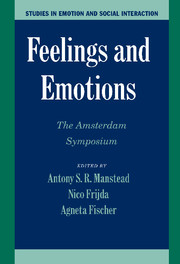Book contents
- Frontmatter
- Contents
- List of Contributors
- 1 Introduction
- PART I THE NATURE OF FEELINGS AND EMOTIONS
- PART II BASIC PSYCHOLOGICAL PROCESSES IN FEELINGS AND EMOTIONS
- 8 What We Become Emotional About
- 9 Feelings Integrate the Central Representation of Appraisal-driven Response Organization in Emotion
- 10 Emotions and Action
- 11 Basic Affects and the Instinctual Emotional Systems of the Brain
- 12 Exposure Effects
- 13 Feeling States in Emotion
- PART III FEELINGS AND EMOTIONS: THE PLACE OF PLEASURE
- PART IV FEELINGS AND EMOTIONS IN THEIR SOCIOCULTURAL CONTEXT
- PART V FEELINGS, EMOTIONS, AND MORALITY
- Subject Index
- Author Index
- Plate section
- References
8 - What We Become Emotional About
Published online by Cambridge University Press: 05 June 2012
- Frontmatter
- Contents
- List of Contributors
- 1 Introduction
- PART I THE NATURE OF FEELINGS AND EMOTIONS
- PART II BASIC PSYCHOLOGICAL PROCESSES IN FEELINGS AND EMOTIONS
- 8 What We Become Emotional About
- 9 Feelings Integrate the Central Representation of Appraisal-driven Response Organization in Emotion
- 10 Emotions and Action
- 11 Basic Affects and the Instinctual Emotional Systems of the Brain
- 12 Exposure Effects
- 13 Feeling States in Emotion
- PART III FEELINGS AND EMOTIONS: THE PLACE OF PLEASURE
- PART IV FEELINGS AND EMOTIONS IN THEIR SOCIOCULTURAL CONTEXT
- PART V FEELINGS, EMOTIONS, AND MORALITY
- Subject Index
- Author Index
- Plate section
- References
Summary
ABSTRACT
The different ways in which emotions are triggered are analyzed. Working from the premise that emotions evolved to prepare us to deal with important events, the most common of these is an automated appraisal system, referred to here as “autoappraisers.” Eight further ways in which emotions are generated are also identified.
We can all remember times when our emotional reaction was inappropriate. It is not that our emotional reaction was too intense, or that our way of expressing it was incorrect; it is that we were feeling the wrong emotion. The problem is not that we got too angry, or that we showed it in the wrong way; we realized afterward that we should not have become angry at all. The issue here is why an inappropriate emotion was being triggered.
The question would not arise if we all reacted the same way when something happened, if every event triggered the same emotion in everyone. Clearly that is not the case; some people are afraid of heights, others are not; some people mourned the death of Princess Diana as if she had been their close relative, while others could not have cared less. Yet there are some triggers that do generate the same emotion in everyone; near-miss car accidents invariably spark a moment of fear. How does this happen? How do we each acquire our own unique set of emotional triggers and at the same time have the same emotional reaction that everyone else has to other triggers?
- Type
- Chapter
- Information
- Feelings and EmotionsThe Amsterdam Symposium, pp. 119 - 135Publisher: Cambridge University PressPrint publication year: 2004
References
- 15
- Cited by



